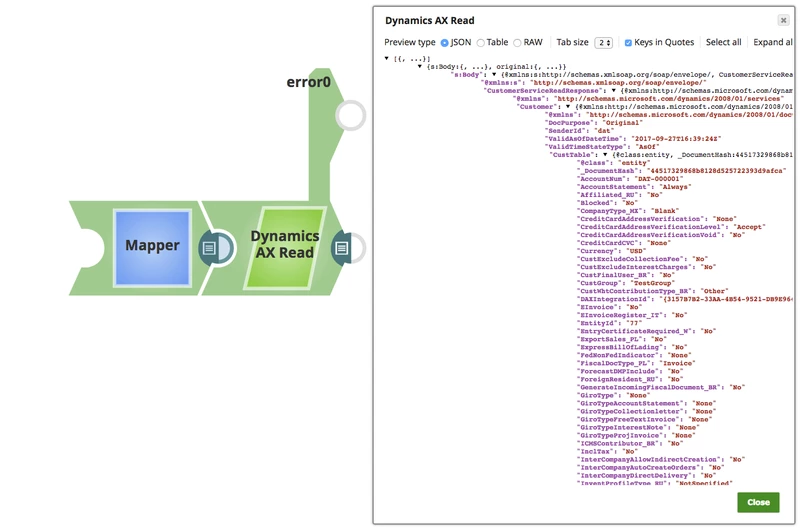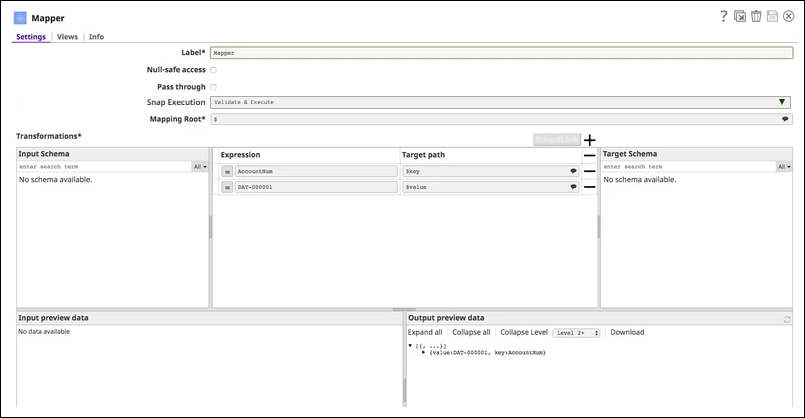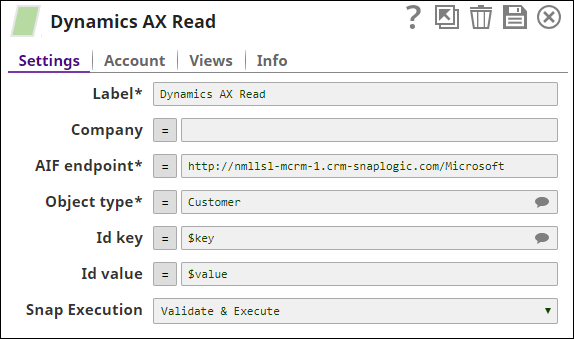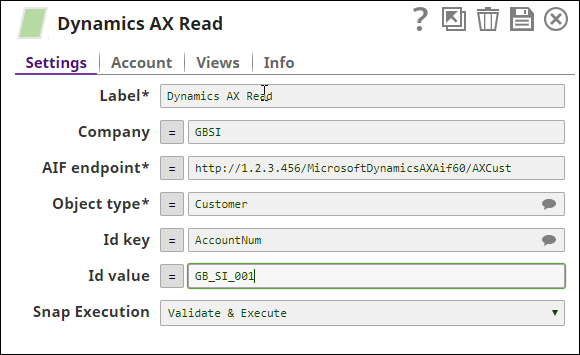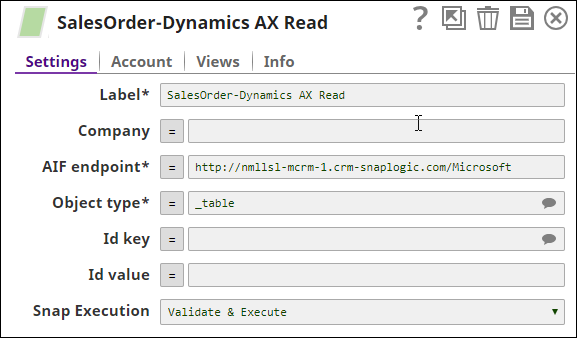Microsoft Dynamics AX Read (Deprecated)
On this Page
| Snap type: | Read | ||||||
|---|---|---|---|---|---|---|---|
| Description: | This Snap reads record from the Dynamics AX instance according to a specific ID key and ID value. ETL Transformations & Data FlowThis Snap enables the following ETL operations or flows: The Snap collects target Dynamics AX instance information from user input or pipeline parameters, and it gets the ID Key and ID Value from user input, pipeline parameters or an upstream Document. It will then use this information to send a SOAP request to the corresponding AIF inbound port on the Dynamics AX instance. The SOAP response from the server will be passed to the downstream Snaps. Input & Output
| ||||||
| Prerequisites: | 1. Microsoft Dynamics AX 2012 instance 2. An enhanced integration inbound port on the AX instance that has one or more Read operations set up | ||||||
| Limitations and Known Issues: | Works in Ultra Tasks. | ||||||
| Configurations: | Account & AccessThis Snap uses account references created on the Accounts page of SnapLogic Manager to handle access to this endpoint. See Configuring Microsoft Dynamics AX Accounts [Deprecated] for information on setting up this type of account. Views
| ||||||
| Troubleshooting: | [None] | ||||||
Settings | |||||||
Label | Required. The name for the Snap. You can modify this to be more specific, especially if you have more than one of the same Snap in your pipeline. | ||||||
| Company | The company name on which to perform the read operation. The company should be defined on the AX instance side. The property can be provided through user input or pipeline parameters. Example: SnapLogic Default value: [None] | ||||||
| AIF endpoint | Required. URI of the inbound port. You may find the information at the Dynamics AX instance: System administration > Setup > Services and Application Integration Framework > Inbound ports > [Your port name] > URI. Example: https://samplelink.crm-snaplogic.com/snapfest Default value: [None] | ||||||
| Object type | Required. The object type on which to perform the read operation. The value of the property depends on the object types contained in the target inbound port. Example: Customer Default value: [None] | ||||||
| Id key | The field name of the record's ID. The field names are different among different object types. It reflects the EntityKey.field in the AIF request. See: Entity Keys Overview The Id Key property is suggestible and:
The property can be provided through user input or pipeline parameters. Example: AccountNum | ||||||
| Id value | The value of the record's ID. It reflects the EntityKey.value in the AIF request. See: Entity Keys Overview When no ID value is provided, the Snap lists out all the records for the given object type. There can be multiple AX objects in the output document as a JSON array. When the ID value is set, there will be at most one AX object in the output document as a JSON object. However, to read a large data sets, you can use the Search Snap. Example: 123 Default value: [None] | ||||||
Snap Execution | Select one of the following three modes in which the Snap executes:
Default Value: Execute only | ||||||
Examples
Basic Use Case
The following pipeline describes how the Snap functions as a standalone Snap in a pipeline:
The pipeline is using a Mapper to simulate an upstream pipeline, and generate a key and value for the Read Snap.
The Dynamics AX Read Snap is configured as shown:
AIF Endpoint
The AIF endpoint is our inbound port URI. Please replace it with your own URI.
The Exported pipeline is available for download in the Downloads section below.
Typical Snap Configurations
Key configuration of the Snap lies in how the data is being passed. There are two ways of doing so in the Microsoft Dynamics AX Read Snap:
- Without Expressions
Data is passed directly into the Snap:
- With Expressions
- Using Pipeline parameters
Data is passed as a pipeline parameter. The parameters to be applied can be selected by enabling the corresponding checkbox under the Capture column:
Advanced Use Case
The following describes a pipeline, with a broader business logic involving multiple ETL transformations, that shows how typically in an enterprise environment, Create, Read, Search and Delete functionalities can be used. See the Pipeline download link below.
This pipeline moves records from a Salesforce instance to the Dynamics AX instance, where the records are created, searched and read for the required IDs and deleted them as needed.
The ETL Transformations:
- Extract: The Salesforce Read Snap retrieves the records from an object type from the Salesforce instance.
- Transform: The Mapper Snap maps the records from the Salesforce object to the Dynamics AX instance.
- Load:The Dynamics AX Create Snap creates the records on the AX instance.
The pipeline further uses:
- The Mapper Snap maps the records to be searched from an Object type.
- The Dynamics AX Search Snap searches all the records.
- The JSON Splitter Snap splits the the records based upon the field names.
- The Dynamics AX Read Snap reads the records based on the given fields and they are retrieved from the bottom using the Tail Snap.
- The Mapper Snap maps the records to be deleted using the Dynamics AX Delete Snap.
Downloads
Important steps to successfully reuse Pipelines
- Download and import the pipeline into the SnapLogic application.
- Configure Snap accounts as applicable.
- Provide pipeline parameters as applicable.
Snap Pack History
Have feedback? Email documentation@snaplogic.com | Ask a question in the SnapLogic Community
© 2017-2025 SnapLogic, Inc.
